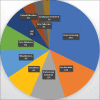Smartphone applications in ophthalmology: A quantitative analysis
- PMID: 33595469
- PMCID: PMC7942060
- DOI: 10.4103/ijo.IJO_1480_20
Smartphone applications in ophthalmology: A quantitative analysis
Abstract
Purpose: There is limited information in literature about the scope and usability of Smartphone Applications (Apps) in ophthalmology. Eye care professionals are therefore skeptical about the benefits of smartphone Apps and are reluctant to adopt it in their day to day practice. The purpose of this study was to provide an updated overview of all Apps exclusive to ophthalmology.
Methods: This study was a quantitative analysis of Smartphone Apps exclusively designed for ophthalmic care. The Apple iPhone and Google play store were searched for eye care themed Apps. Any App related to eye treatment and management such as visual acuity screening, eye education, calculators, eBooks, Low Vision Aids were included in the study. Data on the purpose of the Apps, target end-users, validation, App usage, user ratings, and App developer qualifications were documented.
Results: As of March 2020, a total of 131 Apps exclusively dedicated for eye care were identified. 53% (69/131) were available in iPhones, 44% (58/131) in Android smartphones, and 3% in both. 32% (41/131) Apps were designed for visual acuity (VA) screening, 13% (17/131) for eye relaxation exercises, 12% (15/131) for professional education, and the remaining for Apps detecting color blindness, low vision aids, and assistance and patient education. Among the 131 Apps, 6 (4.5%) Apps are claimed by the developers as validated.
Conclusion: This study unveils a wide range of smartphone Apps exclusive to ophthalmology and suggests guidelines to choose an appropriate App. The study also highlights the importance of interdisciplinary collaboration in the design, development, and validation of such Apps.
Keywords: Apps in Ophthalmology; eye care apps; ophthalmic apps; smartphone applications.
Conflict of interest statement
None
Figures
Comment in
-
Commentary: An app a day keeps the eye doctor busy.Indian J Ophthalmol. 2021 Mar;69(3):553-554. doi: 10.4103/ijo.IJO_2860_20. Indian J Ophthalmol. 2021. PMID: 33595470 Free PMC article. No abstract available.
Similar articles
-
iPhone applications for eye care professionals: a review of current capabilities and concerns.Telemed J E Health. 2014 Apr;20(4):385-7. doi: 10.1089/tmj.2013.0173. Epub 2014 Jan 29. Telemed J E Health. 2014. PMID: 24476190 Review.
-
Smartphone Applications for Amblyopia Treatment: A Review of Current Apps and Professional Involvement.Telemed J E Health. 2018 Oct;24(10):797-802. doi: 10.1089/tmj.2017.0220. Epub 2018 Jan 18. Telemed J E Health. 2018. PMID: 29346038 Review.
-
Smartphone use in ophthalmology: What is their place in clinical practice?Surv Ophthalmol. 2020 Mar-Apr;65(2):250-262. doi: 10.1016/j.survophthal.2019.09.001. Epub 2019 Sep 18. Surv Ophthalmol. 2020. PMID: 31541618 Review.
-
A novel smartphone App to support the clinical practice of pediatric ophthalmology and strabismus: the validation of visual acuity tests.Eur J Pediatr. 2023 Sep;182(9):4007-4013. doi: 10.1007/s00431-023-05058-1. Epub 2023 Jun 29. Eur J Pediatr. 2023. PMID: 37386193
-
Usability of smartphone apps as reading aids for low vision patients.Disabil Rehabil Assist Technol. 2022 Oct;17(7):848-852. doi: 10.1080/17483107.2020.1820086. Epub 2020 Sep 15. Disabil Rehabil Assist Technol. 2022. PMID: 32930007
Cited by
-
Computer vision syndrome among students during remote learning periods: harnessing digital solutions for clear vision.Front Public Health. 2023 Nov 9;11:1273886. doi: 10.3389/fpubh.2023.1273886. eCollection 2023. Front Public Health. 2023. PMID: 38026296 Free PMC article.
-
Applications and implications for extended reality to improve binocular vision and stereopsis.J Vis. 2023 Jan 3;23(1):14. doi: 10.1167/jov.23.1.14. J Vis. 2023. PMID: 36662501 Free PMC article.
-
Evaluation of Patient Experiences with PocDoc, a Web-Based Eye Screening Tool.Ophthalmol Ther. 2024 Jun;13(6):1799-1811. doi: 10.1007/s40123-024-00948-5. Epub 2024 May 6. Ophthalmol Ther. 2024. PMID: 38705913 Free PMC article.
-
Gaps in standards for integrating artificial intelligence technologies into ophthalmic practice.Curr Opin Ophthalmol. 2021 Sep 1;32(5):431-438. doi: 10.1097/ICU.0000000000000781. Curr Opin Ophthalmol. 2021. PMID: 34231531 Free PMC article. Review.
-
Effectiveness of smartphone technology for detection of paediatric ocular diseases-a systematic review.BMC Ophthalmol. 2025 May 30;25(1):323. doi: 10.1186/s12886-025-04160-2. BMC Ophthalmol. 2025. PMID: 40448047 Free PMC article.
References
-
- Rahme RJ, Fishman AJ, Hunt BH, Bendok BR. The future is now: Smartphones to join scalpels and stethoscopes? Neurosurgery. 2012;70:N19–20. - PubMed
-
- Istepanian R, Philip N, Wang XH, Laxminarayan S. Non-telephone healthcare: The role of 4G and emerging mobile systems for future m-health systems. Stud Health Technol Inform. 2004;103:465–70. - PubMed
-
- Low DK, Pittaway AP. The 'iPhone' induction - A novel use for the Apple iPhone. Paediatr Anaesth. 2008;18:573–4. - PubMed
-
- Davis EA, Hovanesian JA, Katz JA, Kraff MC, Trattler WB. Professional life and the smartphone. Cataract Refract Surg Today. 2010:21–2.
-
- Statista.com [Internet]. Smartphone users in India - Penetration rate as share of mobile phone users 2014-2022. [[Updated 2019 Oct 24; cited 2020 Apr 09]]. Available from: https://www.statista.com/statistics/257048/smartphone-user-penetration-i...
Publication types
MeSH terms
LinkOut - more resources
Full Text Sources
Other Literature Sources
Research Materials




